Establishing a morning skincare routine is essential for maintaining radiant and healthy skin. Dermatologists Joshua Zeichner, MD, and Shereene Idriss, MD, recommend a few key steps and skincare products to include in your daily routine for glowing results.
Key Takeaways:
- Follow a consistent morning skincare routine to achieve radiant skin.
- Include cleansing, toning, serum application, moisturizing, and sunscreen protection in your routine.
- Choose high-quality skincare products suitable for your skin type.
- Customize your routine with additional steps like eye creams and treatments for specific concerns.
- Stick to your routine with consistency and make it a pampering ritual.
The Essential Steps of a Morning Skincare Routine
Creating a morning skincare routine is crucial for maintaining healthy, glowing skin throughout the day. By following a consistent routine, you can protect your skin from environmental aggressors, nourish and hydrate it, and effectively address specific concerns. Here are the five essential steps of a morning skincare routine:
Cleansing
Start your morning beauty routine by cleansing your face to remove any impurities or oils that may have accumulated overnight. Choose a gentle cleanser suitable for your skin type, such as a gel or foam formula for oily skin or a cream cleanser for dry or sensitive skin. Massage the cleanser onto damp skin and rinse with lukewarm water to reveal a clean and refreshed complexion.
Toning
Toning is an important step in your morning face care routine as it helps balance the skin’s pH levels, tighten pores, and prepare the skin for better product absorption. Opt for an alcohol-free toner that suits your skin type and apply it with a cotton pad or by gently patting it onto your face. This will help remove any remaining impurities and leave your skin feeling revitalized.
Applying Serum
Next, apply a serum to address specific skincare concerns, such as hydration, brightening, or reducing signs of aging. Serums are lightweight and contain higher concentrations of active ingredients, making them highly effective. Choose a serum that targets your specific needs and gently massage it onto your skin, allowing it to fully absorb before moving on to the next step.
Moisturizing
Hydration is key to maintaining healthy-looking skin, so make sure to moisturize every morning. Select a moisturizer suited to your skin type and concerns, whether it’s a lightweight lotion for oily skin or a richer cream for dry skin. Apply the moisturizer in upward circular motions, ensuring even coverage and allowing it to sink into the skin for optimal hydration.
Protecting with Sunscreen
Defending your skin against harmful UV rays is crucial, regardless of the weather or season. Apply a broad-spectrum sunscreen with an SPF of at least 30 as the final step in your morning skincare routine. Tackle two birds with one stone by selecting a moisturizer formulated with SPF or layering sunscreen on top of your moisturizer. Don’t forget to cover all exposed areas, including your face, neck, and any other skin that will be exposed to the sun.
Consistency is key when it comes to a morning skincare routine. Incorporate these steps into your daily regimen to ensure your skin stays healthy and radiant throughout the day.
| Steps | Description |
|---|---|
| Cleansing | Remove impurities, excess oil, and refresh the skin |
| Toning | Balance pH levels, tighten pores, and improve product absorption |
| Applying Serum | Target specific skincare concerns with concentrated ingredients |
| Moisturizing | Hydrate and nourish the skin for a healthy complexion |
| Protecting with Sunscreen | Shield the skin from harmful UV rays and prevent premature aging |
Cleansing and Toning in the Morning Skincare Routine
One of the essential steps in any morning skincare routine is cleansing and toning. These steps are crucial for removing impurities, excess oil, and preparing the skin for the application of other skincare products. By incorporating proper cleansing and toning techniques into your morning routine, you can achieve healthy, glowing skin throughout the day.
When it comes to choosing a cleanser, it’s important to consider your skin type. For oily or acne-prone skin, opt for a gel or foaming cleanser that helps control excess sebum. Dry or sensitive skin types may benefit from a creamy or hydrating cleanser that doesn’t strip away essential moisture. Combination skin can benefit from gentle cleansers that balance oil production without drying out the skin.
After cleansing, toning is the next step in your morning skincare routine. Toner helps to rebalance the skin’s pH level, tighten pores, and remove any remaining residue. Look for toners that are alcohol-free and contain hydrating ingredients like hyaluronic acid or soothing extracts like chamomile. Applying toner with a cotton pad or by patting it into the skin with clean hands allows for optimal absorption.
By incorporating cleansing and toning into your morning skincare routine, you’ll set the stage for healthier, more radiant skin. Now, let’s move on to the next step: serum application.

I found this helpful table comparing different types of cleansers for various skin types:
| Cleanser Type | Suitable Skin Types | Key Features |
|---|---|---|
| Gel cleanser | Oily, acne-prone | Controls excess sebum, deep cleanses |
| Foaming cleanser | Oily, combination | Removes impurities, leaves a refreshing feel |
| Cream cleanser | Dry, sensitive | Hydrates, gentle on the skin |
Serum Application in the Morning Skincare Routine
Including a serum in your morning skincare routine can provide numerous benefits for your skin. Serums are lightweight, concentrated formulas that deliver active ingredients deep into the skin, targeting specific concerns and providing hydration. Whether you have dry, oily, or combination skin, there is a serum out there to suit your needs.
Choosing the Right Serum for Your Skin Type
When selecting a serum, it’s crucial to consider your skin type and specific concerns. Here are some recommendations:
- For dry skin: Look for serums that contain hyaluronic acid or ceramides to deeply hydrate and restore moisture to your skin.
- For oily skin: Opt for lightweight serums with ingredients like niacinamide or salicylic acid to regulate oil production and minimize pore appearance.
- For combination skin: Choose serums that offer a balance of hydration and oil control, such as those containing antioxidants like vitamin C.
Remember, everyone’s skin is unique, so it’s essential to find a serum that works best for you by considering your individual needs and concerns.
Application Technique
Proper application of the serum ensures maximum efficacy and absorption. Follow these steps:
- Start with freshly cleansed skin in the morning.
- Apply a pea-sized amount of serum onto your fingertips.
- Gently massage the serum onto your face and neck using upward, circular motions.
- Allow the serum to fully absorb into the skin before applying any other skincare products.
The serum should be applied after cleansing and toning, and before moisturizing and applying sunscreen. This allows the active ingredients in the serum to penetrate the skin more effectively.
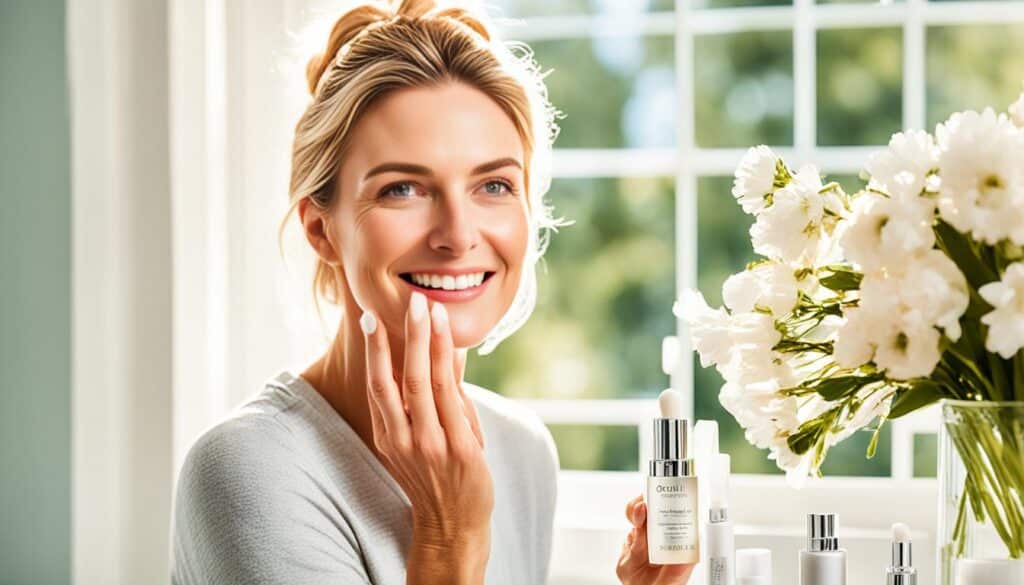
Remember, consistency is key when incorporating serum into your morning skincare routine. Over time, you’ll start to notice the positive effects of including a serum in your daily regimen, such as improved hydration, enhanced skin texture, and a more radiant complexion.
Moisturizing in the Morning Skincare Routine
Moisturizing is a crucial step in your morning skincare routine to keep your skin hydrated, improve its texture, and reduce the appearance of fine lines. It replenishes moisture lost during sleep and creates a protective barrier against environmental stressors.
When choosing a moisturizer, consider your skin type and its specific needs. For dry skin, opt for a rich, nourishing moisturizer that deeply hydrates and prevents moisture loss throughout the day. Look for ingredients like hyaluronic acid, which attracts and retains moisture, leaving your skin plump and supple.
If you have oily or combination skin, go for lightweight, non-comedogenic moisturizers that provide hydration without clogging pores. These types of moisturizers often have a gel or serum-like consistency, which absorbs quickly into the skin.
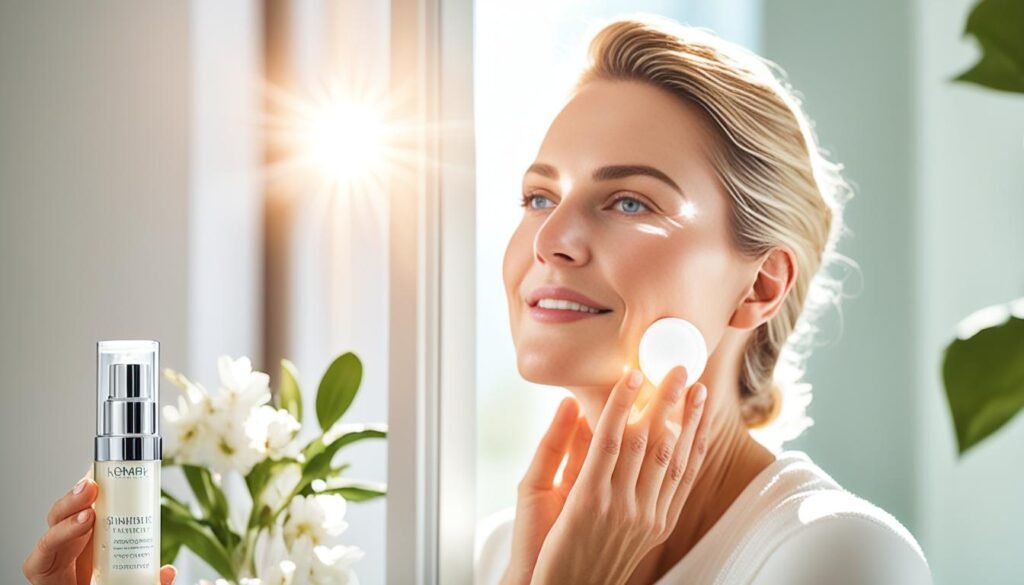
Remember to apply your moisturizer to clean, toned skin. Use gentle upward motions to massage the product into your face and neck, ensuring even distribution.
To enhance the effectiveness of your moisturizer, consider layering it over a hydrating serum or essence. This will provide an extra boost of hydration and help the moisturizer penetrate deeper into the skin.
Make sure to apply moisturizer both in the morning and evening for optimal results. This will keep your skin hydrated throughout the day and night, promoting a healthy complexion.
| Skin Type | Recommended Moisturizers |
|---|---|
| Dry Skin | 1. CeraVe Moisturizing Cream 2. Neutrogena Hydro Boost Gel Cream 3. La Roche-Posay Toleriane Double Repair Face Moisturizer |
| Oily/Combination Skin | 1. The Ordinary Natural Moisturizing Factors + HA 2. Cetaphil Oil Control Moisturizer SPF 30 3. Clinique Dramatically Different Moisturizing Gel |
By incorporating a moisturizer into your morning skincare routine, you can maintain a well-hydrated complexion, prevent dryness, and promote youthful-looking skin. Don’t forget to choose a moisturizer that suits your skin type and targets your specific concerns to achieve the best results.
Sunscreen as a Vital Step in the Morning Skincare Routine
Protecting your skin from harmful UV rays is crucial for maintaining its health and preventing premature aging. Incorporating sunscreen into your morning skincare routine is a vital step in achieving this. Applying a broad-spectrum SPF 30 or higher sunscreen helps safeguard your skin from both UVA and UVB rays, reducing the risk of sunburn, skin damage, and skin cancer.
By including sunscreen in your daily skincare regimen, you prioritize the long-term health and appearance of your skin. Sunscreen acts as a protective shield, preventing free radicals from causing damage and reducing the risk of photoaging, such as wrinkles, dark spots, and sagging skin.
“Sunscreen is the best anti-aging product in your skincare arsenal. It helps prevent premature aging by shielding your skin from harmful UV rays,” says dermatologist Dr. Ava Shamban.
When choosing a sunscreen, opt for a broad-spectrum formula that provides protection against both UVA and UVB rays. Look for a minimum SPF 30, which blocks 97% of UVB rays. If you have sensitive skin or are prone to breakouts, look for non-comedogenic and fragrance-free options to avoid clogging pores or triggering allergies.
Remember to apply sunscreen generously to all exposed areas of your skin, including your face, neck, ears, and hands. Reapply every two hours, especially if you are spending time outdoors or engaging in activities that may cause sweating or rubbing off the product.
Make sunscreen a non-negotiable step in your morning skincare routine, ensuring that you protect your skin from the sun’s harmful rays and maintain its overall health and beauty.
| Benefits of Sunscreen in the Morning Skincare Routine | Choosing the Right Sunscreen | Application Tips |
|---|---|---|
|
|
|
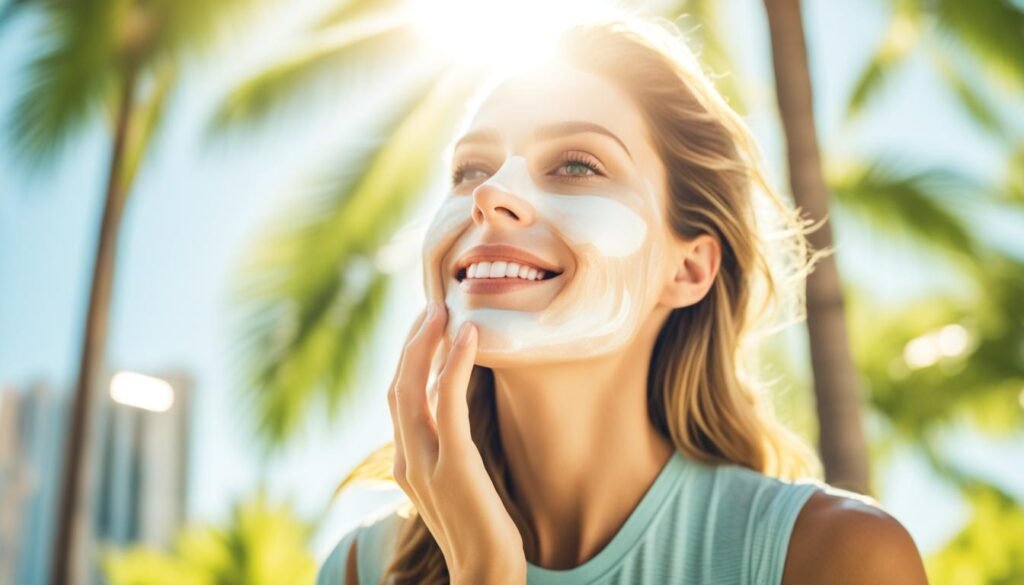
Additional Steps for a Customized Morning Skincare Routine
While the essential steps of a morning skincare routine lay the foundation for healthy and radiant skin, there are additional steps you can take to customize your routine and address specific skin concerns. Incorporating targeted skincare products can enhance the effectiveness of your morning regimen, providing added benefits and nourishment for your skin.
Eye Creams for Brighter, Youthful Eyes
The delicate skin around the eyes requires extra care and attention. Including an eye cream in your morning skincare routine can help reduce puffiness, dark circles, and fine lines. Look for eye creams that contain ingredients like peptides and hyaluronic acid to hydrate and firm the under-eye area. Gently pat the eye cream around the orbital bone using your ring finger for optimal absorption.
Treatments for Specific Skin Concerns
If you have specific skin concerns, such as acne, hyperpigmentation, or aging, incorporating targeted treatments can help address them effectively. For acne-prone skin, consider using pimple-busting treatments that contain ingredients like salicylic acid or benzoyl peroxide. To reduce hyperpigmentation, look for serums or treatments that contain ingredients like vitamin C or niacinamide. And for anti-aging benefits, consider incorporating products with retinol or peptides into your routine.
Antioxidants for Enhanced Protection
Antioxidants play a crucial role in protecting your skin from environmental damage and oxidative stress. Adding antioxidants, such as vitamin C or green tea extract, to your morning skincare routine can help neutralize free radicals and provide an extra layer of defense against pollution and UV rays. Look for serums or moisturizers that contain antioxidants and apply them after cleansing and toning.
Toners for Additional Hydration
Toners are not just for balancing your skin’s pH level; they can also provide an extra boost of hydration. Opt for hydrating toners that contain ingredients like hyaluronic acid or glycerin. Gently pat the toner onto your skin after cleansing to lock in moisture and prepare your skin for subsequent skincare steps.
| Targeted Skincare Products | Key Benefits |
|---|---|
| Eye Creams | Reduced puffiness, dark circles, and fine lines around the eyes. |
| Treatments | Address specific skin concerns such as acne, hyperpigmentation, and aging. |
| Antioxidants | Enhanced protection against environmental damage and oxidative stress. |
| Toners | Additional hydration for the skin. |
Summary
Customizing your morning skincare routine with targeted products allows you to address specific skin concerns and boost the overall effectiveness of your regimen. Incorporating eye creams, treatments, antioxidants, and toners can provide added hydration, protection, and nourishment for your skin. Remember to choose products suitable for your skin type and concerns, and always follow recommended application techniques for optimal results.
The Importance of Consistency in a Morning Skincare Routine
Maintaining a consistent skincare routine is key to achieving optimal results for your skin. When it comes to your morning skincare routine, consistency is especially important. By following a consistent routine, you can provide your skin with the care it needs to stay healthy and radiant throughout the day.
Consistency in your morning skincare routine involves performing the same steps and using the same products every day. This helps create a stable environment for your skin and allows the products to work effectively over time.
Here are some tips to help you stick to your morning skincare routine:
- Set out your skincare products in advance: Prepare your skincare products the night before or organize them in a way that makes them easily accessible in the morning. This will help save time and ensure you don’t skip any steps.
- Make it a pampering ritual: Treat your morning skincare routine as a self-care ritual. Take a few extra minutes to enjoy the process, and view it as a moment of relaxation and rejuvenation.
- Stay motivated by tracking progress: Take note of any improvements you see in your skin as a result of your consistent routine. This can help keep you motivated and committed to maintaining your skincare regimen.
- Find a routine that works for you: Choose products that suit your skin type and address your specific concerns. A skincare routine that is tailored to your needs is more likely to deliver satisfying results, which can further incentivize you to stick to the routine.
- Involve accountability partners: Share your skincare goals and journey with a friend or family member who can hold you accountable. Discuss your progress and encourage each other to stay consistent.
Consistency is key when it comes to your morning skincare routine. By sticking to a set routine, you can establish healthy habits that will benefit your skin in the long run.

Remember, the best skincare routine is one that you can realistically maintain over time. Consistency is key, so find a routine that works for you and make it a part of your daily morning ritual.
Expert Tips for an Effective Morning Skincare Routine
When it comes to your morning skincare routine, dermatologists have invaluable insights to help you achieve your desired results. Consulting a dermatologist can provide personalized advice tailored to your specific skin concerns and needs. By understanding how different factors contribute to the effectiveness of your routine, you can optimize your skincare practices for radiant and healthy-looking skin.
Here are some expert tips from dermatologists to enhance your morning skincare routine:
“Consulting a dermatologist can contribute significantly to achieving your skincare goals. They can assess your skin type, identify any underlying issues, and recommend targeted products and techniques.” – Dr. Emily Smith, Dermatology Specialist
Understand Your Skin Type and Concerns
A dermatologist can help you determine your skin type and identify any specific concerns you may have, such as acne, dryness, sensitivity, or signs of aging. This knowledge is crucial in selecting the right products and developing a tailored routine that addresses your unique needs.
Choose Quality Products
A dermatologist can guide you in choosing high-quality skincare products that are suitable for your skin type and concerns. They can recommend ingredients to look for, such as hyaluronic acid for hydration or retinol for anti-aging benefits. Using products recommended by a dermatologist ensures that you are investing in effective and safe formulations.
Consider External Factors
External factors, such as climate, pollution, and lifestyle habits, can impact your skin health. Dermatologists can provide insights on how these factors contribute to your desired results and suggest preventive measures or adjustments to your skincare routine. For example, they might recommend antioxidants to combat pollution-related damage or emphasize the importance of sunscreen in sunny climates.
Establish Clear Skincare Goals
A dermatologist can help you set realistic skincare goals and create a step-by-step plan to achieve them. Whether it’s improving skin texture, reducing hyperpigmentation, or managing skin conditions, collaborating with a dermatologist allows you to personalize your routine for optimal results.
Remember, while expert advice can be invaluable, consistency is key. Stick to your morning skincare routine diligently and monitor the improvements over time. By working in partnership with a dermatologist and following their guidance, you can unlock the potential of your morning skincare routine and enjoy healthier, glowing skin.
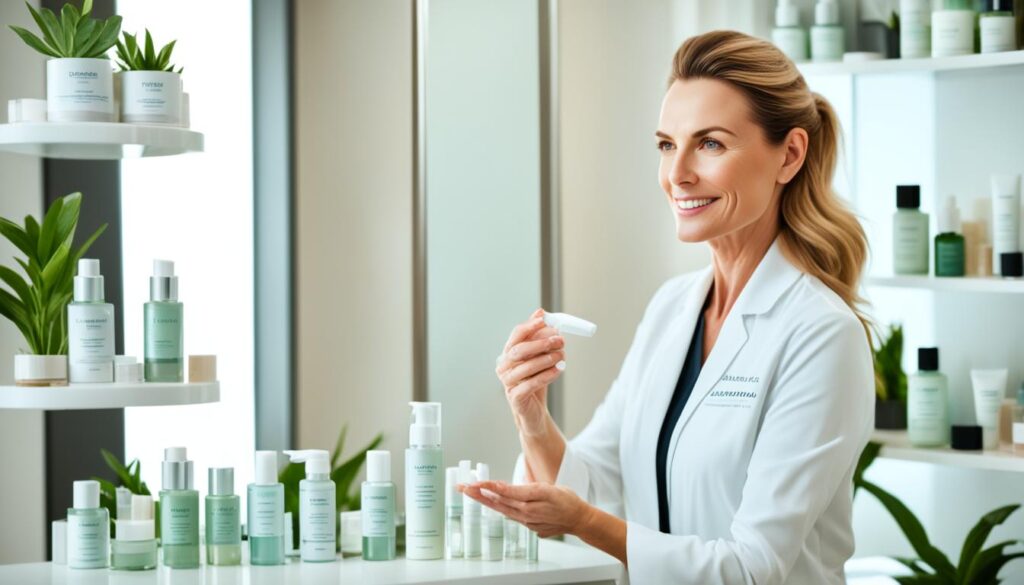
The Correct Order of Applying Morning Skincare Products
Applying skincare products in the correct order is crucial for achieving optimal absorption and effectiveness. A step-by-step guide based on product thickness can help you streamline your morning skincare routine and maximize its benefits.
1. Cleanser: Start by cleansing your face to remove any impurities and prepare your skin for the following steps. Choose a cleanser suitable for your skin type.
2. Toner: After cleansing, apply a toner to balance your skin’s pH levels and enhance its overall appearance. Look for a toner that suits your skin’s specific needs.
3. Serum: Apply a serum that targets your skin concerns, such as hydration, brightening, or anti-aging. Serums are usually lightweight and easily absorbable, making them an ideal choice for this step.
4. Moisturizer: Follow up with a moisturizer to hydrate and nourish your skin. Choose a moisturizer that suits your skin type and includes ingredients like hyaluronic acid for intense hydration.
5. Sunscreen: Finish off your morning skincare routine by applying a broad-spectrum sunscreen with an SPF of 30 or higher. This step is crucial for protecting your skin from harmful UV rays.
Remember, consistency is key when it comes to skincare. Stick to your morning skincare routine to maintain healthy and radiant-looking skin.

| Step | Product |
|---|---|
| 1 | Cleanser |
| 2 | Toner |
| 3 | Serum |
| 4 | Moisturizer |
| 5 | Sunscreen |
A Personalized Spring Morning Skincare Routine Example
As the seasons change, it’s essential to adapt your skincare routine to meet the specific needs of your skin. In spring, when the weather becomes milder and less harsh, you can incorporate hydrating bases, exfoliating, oils, and lighter moisturizing products to achieve a healthy and radiant complexion.
Step 1: Cleansing with a Hydrating Base
Start your morning skincare routine by cleansing your face with a gentle cleanser that provides hydration. Look for a cleanser formulated with hydrating ingredients like hyaluronic acid or aloe vera, which can replenish moisture while effectively removing any impurities. Massage the cleanser onto damp skin in circular motions, then rinse thoroughly with lukewarm water.
Step 2: Exfoliating for Smooth Skin
Exfoliation is crucial for removing dead skin cells and revealing a fresh, radiant complexion. Use a gentle exfoliator with fine particles or chemical exfoliants like alpha-hydroxy acids (AHAs) or beta-hydroxy acids (BHAs). Apply the exfoliant to damp skin and gently massage in circular motions, focusing on areas prone to dryness or dullness. Rinse off with lukewarm water and pat your skin dry.
Step 3: Nourishing with Facial Oils
Facial oils are excellent for providing deep hydration and nourishment to the skin. Choose a lightweight facial oil suitable for your skin type, such as rosehip oil for dry skin or jojoba oil for oily skin. Gently massage a few drops of the oil onto your face and neck using upward motions. Allow it to absorb fully before moving on to the next step.
Step 4: Moisturizing with Lightweight Products
In spring, you can switch to lighter moisturizers that provide hydration without feeling heavy on the skin. Opt for gel or lotion-based moisturizers that are quickly absorbed and leave your skin feeling refreshed. Look for moisturizers infused with hyaluronic acid, which helps retain moisture and plump the skin. Apply the moisturizer to your face and neck, gently massaging it in until fully absorbed.
Step 5: Sun Protection Is Key
Even in spring, it’s essential to protect your skin from harmful UV rays. Apply a broad-spectrum sunscreen with at least SPF 30 as the final step in your morning skincare routine. Make sure to cover all exposed areas, including your face, neck, and any other areas prone to sun exposure. Reapply throughout the day, especially if you’ll be spending time outdoors.
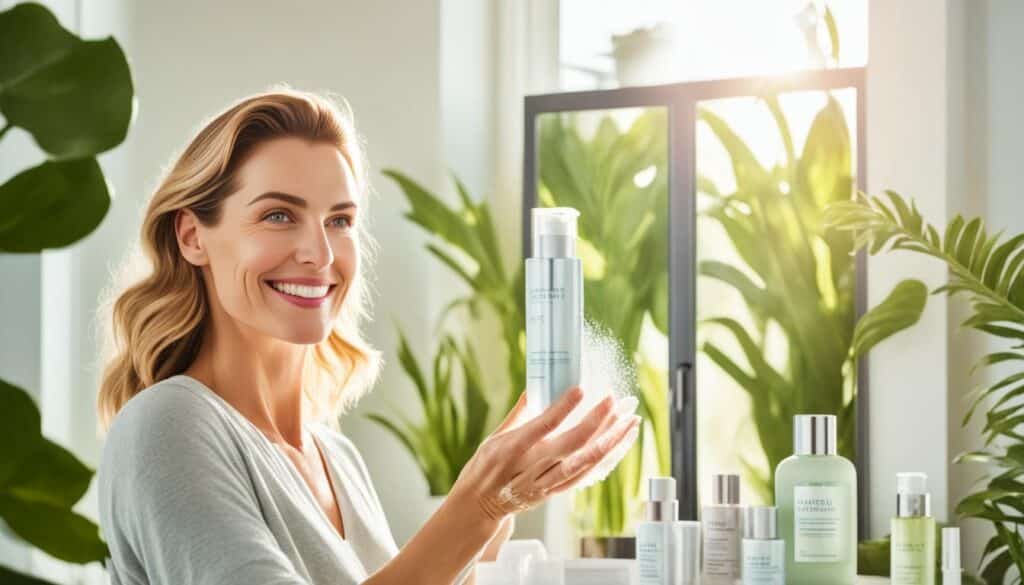
Remember, this spring morning skincare routine is just an example, and you can tailor it to suit your specific skin needs. Listen to your skin, and don’t be afraid to experiment with different products and techniques until you find the perfect routine that leaves your skin looking and feeling its best.
Also Read : Essential Skincare Routine for Oily Skin Tips
Conclusion
Incorporating a consistent skincare routine into your daily morning routine is essential for achieving radiant and healthy-looking skin. By following the key steps discussed in this article, you can provide your skin with the care it needs to thrive.
Start with a thorough cleanse and toning to remove impurities and prepare your skin for the next steps. Applying a serum tailored to your skin type helps address specific concerns and provides hydration. Follow this with a moisturizer that locks in moisture and promotes a smooth, youthful complexion. And don’t forget the all-important step of sunscreen application to shield your skin from harmful UV rays.
Remember, consistency is key in any skincare routine. Stick to your morning routine daily to reap the maximum benefits. You can also personalize your routine by incorporating additional steps, such as eye creams, treatment products, antioxidants, and toners.
So, make skincare in the morning a priority. Adapt your routine based on your skin’s specific needs and consult with a dermatologist for personalized advice. With a dedicated skincare routine, you can achieve the healthy, glowing complexion you desire.
FAQ
Q: What is the importance of a morning skincare routine?
A: A morning skincare routine is essential to cleanse your skin from dirt, oil, and bacteria accumulated overnight and to prepare your skin for the day ahead.
Q: How should I wash my face in the morning?
A: Use a gentle cleanser suited for your skin type to wash your face in the morning, ensuring to remove any impurities without stripping your skin of its natural oils.
Q: Is moisturizing in the morning necessary?
A: Yes, moisturizing in the morning helps maintain your skin’s moisture barrier and provides hydration throughout the day, especially if you have dry skin.
Q: How can I protect my skin from the sun in the morning?
A: Applying a broad spectrum SPF 30 or higher sunscreen is crucial to protect your skin from the harmful effects of UV rays and prevent issues like dark spots and premature aging.
Q: Can I use a gel-based moisturizer for oily skin in the morning?
A: Yes, a gel-based moisturizer is lightweight and absorbs quickly, making it ideal for oily skin types in the morning to provide hydration without feeling greasy.
Q: What is the benefit of following a skincare regimen in the morning?
A: Following a skincare regimen in the morning helps clarify and brighten your skin, target specific concerns like acne or dark spots, and boost its overall radiance.
Q: How often should I apply sunscreen in the morning?
A: It is recommended to apply sunscreen with at least SPF 30 every morning, and if you’ll be outdoors for an extended period, opt for SPF 50 for extra protection.
